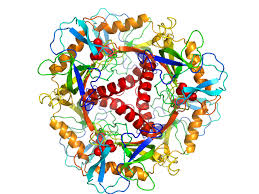CM4012
Carbomenu has protein expression platform in both prokaryotic cells (E.coil) and eukaryotic cells (Yeast/CHO-k1/293). Carbomenu is able to deal with kilogram level customized protein production orders. Our product line can be optimized according to customer orders to meet personalized needs.
Information
Known as: | Inorganic pyrophosphatase, PPase |
Cat.No.: | CM4012 |
Expression Host: | Ecoli. Yeast |
Package: | Customed |
Price: | Inquiry |
Introduction
Pyrophosphatase(Inorganic) can catalyze the hydrolysis of Inorganic pyrophosphate into orthophosphate P2O74-+H2O+PPase→2HPO42-, which can remove the inhibition of Inorganic pyrophosphate and provide thermodynamic power for the reaction to promote the generation of products. It is a good adjuvant used in the biosynthesis of RNA, DNA and protein. It can significantly increase the yield of mRNA vaccine in vitro large-scale synthesis.
Features
Hydrolyzed pyrophosphatase;
Significantly enhance DNA replication capacity;
Increased RNA production in vitro transcriptional reactions;
The best reaction temperature is 25℃, 65℃ for 10min can deactivate the enzyme.
Usage Suggestion
1) PPase can keep active in a large scale of buffer. It could be directly added in HDA amplification and LAMP amplification experiments.
2) In different experiments, the dosage needs to be optimized.
3) PPase can keep active at 16-37 ℃. The optimal reaction temperature is at 25℃. It could be inactivated at 65℃ for 10min.
Storage
Store at -20℃.
For research and manufacturing use only.
Reference
1.Ko KM, Lee W, Yu JR, Ahnn J (November 2007). "PYP-1, inorganic pyrophosphatase, is required for larval development and intestinal function in C. elegans". FEBS Letters. 581 (28): 5445–53.
2.Usui Y, Uematsu T, Uchihashi T, Takahashi M, Takahashi M, Ishizuka M, et al. (May 2010). "Inorganic polyphosphate induces osteoblastic differentiation". Journal of Dental Research. 89 (5): 504–9.
3. Sitnik TS, Avaeva SM (January 2007). "Binding of substrate at the effector site of pyrophosphatase increases the rate of its hydrolysis at the active site". Biochemistry. Biokhimiia. 72 (1): 68–76.
4.Rodina EV, Vorobyeva NN, Kurilova SA, Belenikin MS, Fedorova NV, Nazarova TI (January 2007). "ATP as effector of inorganic pyrophosphatase of Escherichia coli. Identification of the binding site for ATP". Biochemistry. Biokhimiia. 72 (1): 93–9.



